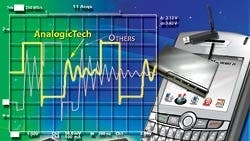Advanced Analogic Technologies’ AAT2120 and AAT2158 low-noise buck converters promise to replace the linear regulators that typically drive RF and other noise-sensitive circuitry in mobile phones. The use of these converters will ultimately translate into extended battery life and improved system performance for many portable wireless applications. Because of the advantages of this low-noise technology, these first two devices will be followed by several generations of other unique switching regulators.
The low-noise characteristics of these first two buck converters yield significantly lower spectral noise and output ripple when compared to conventional switching regulators. According to David Brown, director of application engineering at Advanced Analogic Technologies, this unique topology enables the synchronous stepdown converters to deliver improved performance by using a low-noise rectifier, replacing the typical low-side synchronous switch in a conventional buck topology. This feature enables the converters to produce half the ringing amplitude of conventional synchronous switching regulators (see the Figure).
At higher currents, the two converters also produce approximately 25% less output ripple. This reduction in conducted ripple, combined with the reduction in radiated RF switching noise generated by ringing, enables these regulators to improve system performance when compared to applications powered by traditional switching regulators.
For example, Brown states that in one test designed to quantify power improvements in an RF transmitter using the low-noise-rectifier technology, a converter based on a conventional synchronous-buck topology was compared to an otherwise-identical converter using the low-noise-rectifier topology. A 900-MHz ISM-band FSK transmitter was powered using both devices, and the RF output of the transmitter was measured for each configuration using a spectrum analyzer. When this RF system used the low-noise-rectifier topology, the carrier signal’s adjacent channel power was reduced by more than 3 dB in comparison to that generated when the same RF system used the conventional regulator.
In addition to this improved performance, high power efficiencies for the AAT2120 and AAT2158, respectively 96% and 95%, can justify their use as substitutes for LDOs in many supply-noise-sensitive wireless and portable applications. Moreover, by operating at high switching frequencies, both devices minimize the size of external components. In fact, according to Brown, the low-noise-rectifier switching topology can be scaled further up or down in frequency. Therefore, next-generation products can leverage increased switching frequencies to enable greater reductions in the size and cost of external components than would be possible using conventional switching topologies.
High-frequency operation also opens other interesting possibilities. This includes the possibility of using the low-noise-rectifier technology to reduce the switching noise in converters with integrated inductors.
However, to support higher currents needed for applications such as driving high-power RF amplifiers, Brown states that external inductors are still preferred. Therefore, the AAT2120 supplies up to 500 mA output of current, while the AAT2158 delivers up to 1.5 A, making them ideal for use in many wireless and portable products. Operating from an input range of 2.7 V to 5.5 V, and supporting output voltages as low as 0.6 V, both devices are compatible with Li-ion and Li-polymer batteries currently used in these applications.
Brown also states that because battery life, reduced regulator size and noise performance are the main benefits provided by these and future devices using low-noise-rectifier topologies, future designs will be needed to accommodate evolving battery technologies used for mobile applications.
Specifically, Advanced Analogic Technologies is working on boost and buck-boost converters using low-noise-rectifier architectures. These architectures will address emerging Li-ion battery technologies having more linear discharge curves and reduced operating-voltage ranges. However, for the interim, power designers can use the AAT2120 and AAT2158 to realize improved performance in their portable and wireless applications.
